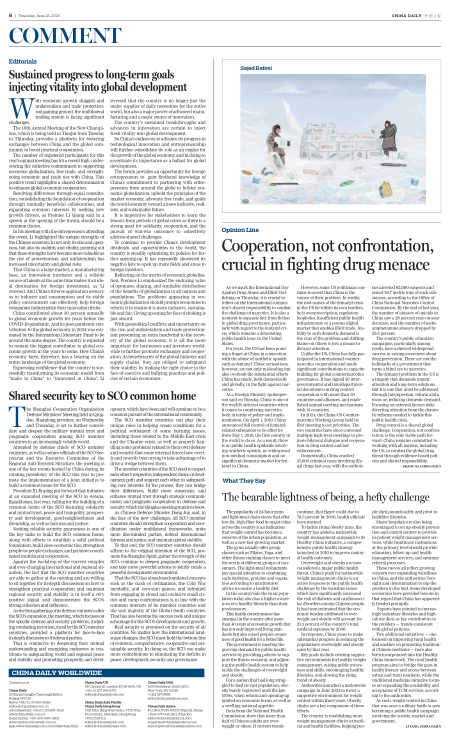As we mark the International Day Against Drug Abuse and Illicit Trafficking on Thursday, it is crucial to reflect on the international community's shared responsibility to combat the challenge of narcotics. It is also a moment to separate fact from fiction in global drug governance, particularly with regard to the fentanyl crisis, which remains a devastating public health issue in the United States.
For years, the US has been pointing a finger at China in connection with the abuse of synthetic opioids such as fentanyl. These accusations, however, are not only misleading but also overlook the substantial efforts China has made, both domestically and globally, in the fight against narcotics.
As a Foreign Ministry spokesperson said on Tuesday, China is one of the world's strictest countries when it comes to countering narcotics, both in terms of policy and implementation. On April 1, 2019, China announced full control of fentanyl-related substances to be effective from May 1, 2019, the first country in the world to do so. As a result, there is no public health epidemic involving synthetic opioids, no widespread non-medical consumption and no significant domestic market for fentanyl in China.
However, some US politicians continue to assert that China is the source of their problem. In reality, the root causes of the fentanyl crisis in the US lie within its own borders, be it overprescription, regulatory loopholes, insufficient public health infrastructure or a porous digital market that enables illicit trade. Inability to curb domestic demand is the crux of the problem and shifting blame on others is just a means to distract attention.
Unlike the US, China has fully participated in international counternarcotics cooperation and made significant contributions to capacity-building for global counternarcotics governance. It has signed 50 intergovernmental and interdepartmental documents on drug control cooperation with more than 30 countries and alliances, and established annual meeting mechanisms with 13 countries.
In 2024, the China-US Counternarcotics Working Group held its first meeting to set priorities. The two countries have since convened multiple high-level meetings to promote bilateral dialogue and cooperation in drug control and law enforcement.
Domestically, China cracked 37,000 criminal cases involving illegal drugs last year, with the authorities arrested 62,000 suspects and seized 26.7 metric tons of such substances, according to the Office of China National Narcotics Control Commission. By the end of last year, the number of abusers of opioids in China saw a 28 percent year-on-year decrease, and the number of methamphetamine abusers dropped by 23.3 percent.
The country's public education campaigns, particularly among youth, have achieved widespread success in raising awareness about drug prevention. These are not the hallmarks of a government that turns a blind eye to narcotics.
The fentanyl problem in the US is a tragedy that demands urgent attention and long-term solutions. But it is one that must be addressed through introspection, reform and a focus on reducing domestic demand. Focusing on external factors risks diverting attention from the domestic reforms needed to tackle this public health crisis.
Drug control is a shared global challenge. Cooperation, not confrontation, is the only viable path forward. China remains committed to working with all nations, including the US, to combat the global drug threat through evidence-based policies and shared responsibility.

